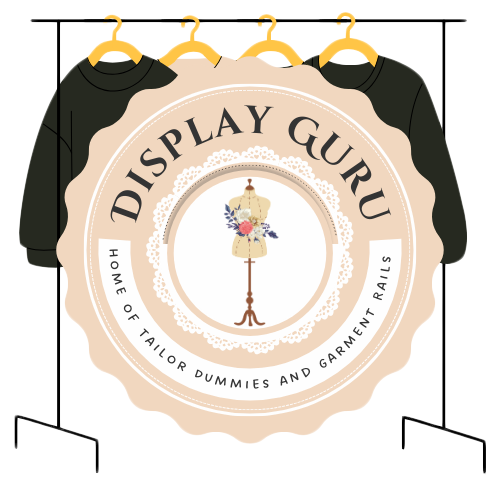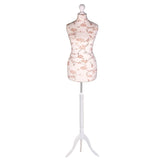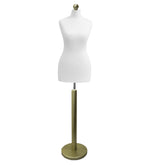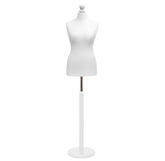Top Sewing Accessory Box Tips for Organizing Your Supplies
Before you can even think about buying a new sewing box, you need to get a clear picture of what you actually own. A truly organised sewing space doesn’t start with a shopping trip; it begins with a good old-fashioned sort-out of your current tools and notions.
Audit Your Sewing Supplies for a Perfect Fit
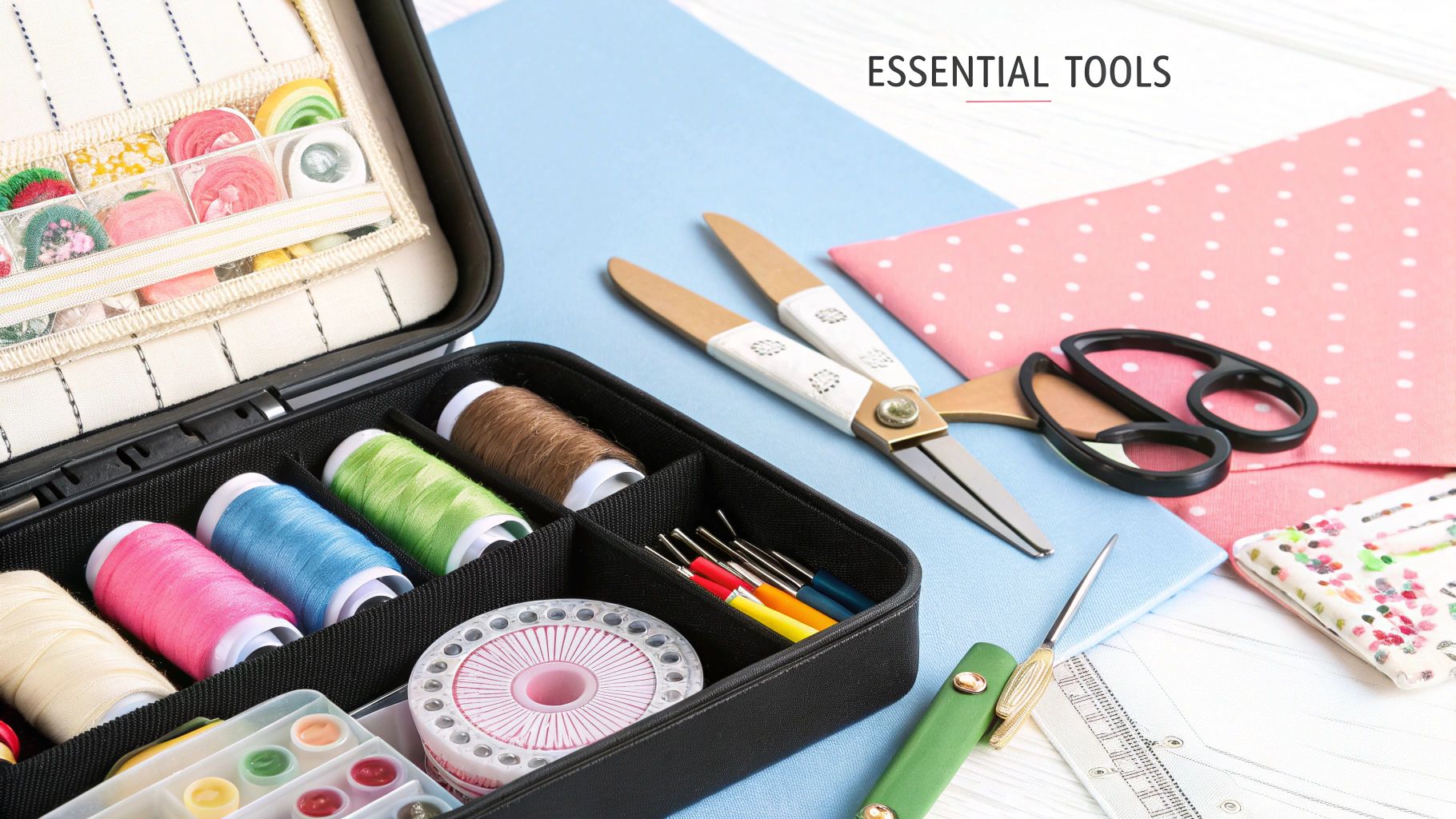
The first real step is to gather everything in one place. I mean everything. Tip out every drawer, rummage through those old biscuit tins, and empty every half-finished project bag onto a clean floor or a large table. We're talking every spool of thread, each packet of needles, that ever-growing collection of bobbins, speciality presser feet, marking tools, and yes, even those two extra seam rippers you completely forgot you had.
With your entire collection laid out before you, you can start sorting things into logical groups. Don't get bogged down in perfection here; just create piles that make sense to you and how you work.
Categorise Your Tools
Try grouping items by what they do. This gives you a much clearer sense of the space each category needs. For example, you could create piles for:
- Cutting Tools: Fabric shears, rotary cutters, thread snips, and pinking shears.
- Marking Supplies: Tailor's chalk, fabric pens, and tracing wheels.
- Stitching Essentials: Needles, pins, clips, and thimbles.
- Measuring Tools: Tape measures, quilting rulers, and seam gauges.
- Machine Accessories: Presser feet, bobbins, and little cleaning brushes.
This process is incredibly revealing. You might suddenly realise your pin collection has well and truly outgrown that little magnetic dish, or that you desperately need a better way to organise your bobbins.
This isn't just about tidying up. It's about getting to know your personal workflow so you can choose a box that makes finding any tool feel completely effortless and intuitive.
Distinguish Daily Drivers from Speciality Gear
Next, it’s time to be honest about what you use all the time versus what only comes out for specific projects. Your favourite fabric shears and go-to thread colours need to be front and centre, ready to grab. On the other hand, things like a buttonhole cutter or a particular embroidery hoop can be stored somewhere less prominent.
This audit is also a fantastic opportunity to rethink your entire sewing space. For more tips on layout and flow, have a look at our guide on sewing room ideas for more inspiration.
With home sewing more popular than ever, the demand for smart organisation is on the rise. In fact, the UK sewing machine market—which is closely tied to accessories—brought in USD 116.7 million in 2024 and is projected to keep growing. This just goes to show how many of us are realising that a well-organised accessory box is key to an efficient and enjoyable hobby.
How to Choose the Right Sewing Accessory Box
Now that you have a clear picture of what you own, it's time for the fun part: picking the perfect sewing accessory box. The sheer variety out there can feel overwhelming, from classic wooden cantilever boxes to sleek, modern plastic units. The trick is to think less about how a box looks and more about how you actually sew.
Start with the Material
The material of your box really sets the tone for its use. I’ve worked with all kinds, and each has its place.
- Wood: There’s something so satisfying about a traditional wooden sewing box. They’re built to last a lifetime and look beautiful in a sewing room. The downside? They can be quite heavy and are usually a bigger investment.
- Plastic: A practical and popular choice for good reason. Plastic boxes are lightweight, affordable, and often come with transparent lids so you can see what’s inside. Just be sure to find a sturdy type that won’t crack when filled with your heavier tools.
- Fabric: If you ever take your sewing to a friend’s house or a class, a fabric tote or soft case is your best friend. They’re designed for portability, though they might not offer as much protection for very sharp or delicate items.
Look for Features That Fit Your Craft
Once you’ve settled on a material, the real magic is in the details. The right features can completely change your sewing experience. For instance, if you’re a quilter juggling countless small notions, a box with adjustable dividers is a non-negotiable. You can create tiny compartments for bobbins and pins one day, and larger slots for fat quarters the next.
On the other hand, if you're making garments, you'll need space for bulkier kit. Think about where you’ll put your large fabric shears, rolls of tracing paper, or those big cones of overlocker thread. A box with deep compartments or removable trays can be a game-changer. I love being able to pull out a single tray with just my essentials and place it right next to my machine.
A clear-top lid is more than just a convenience; it's a time-saver. Being able to see exactly what’s inside at a glance means less time hunting and more time creating.
This image gives a great overview of the different styles you might come across, helping you to visualise which one might work best for you.
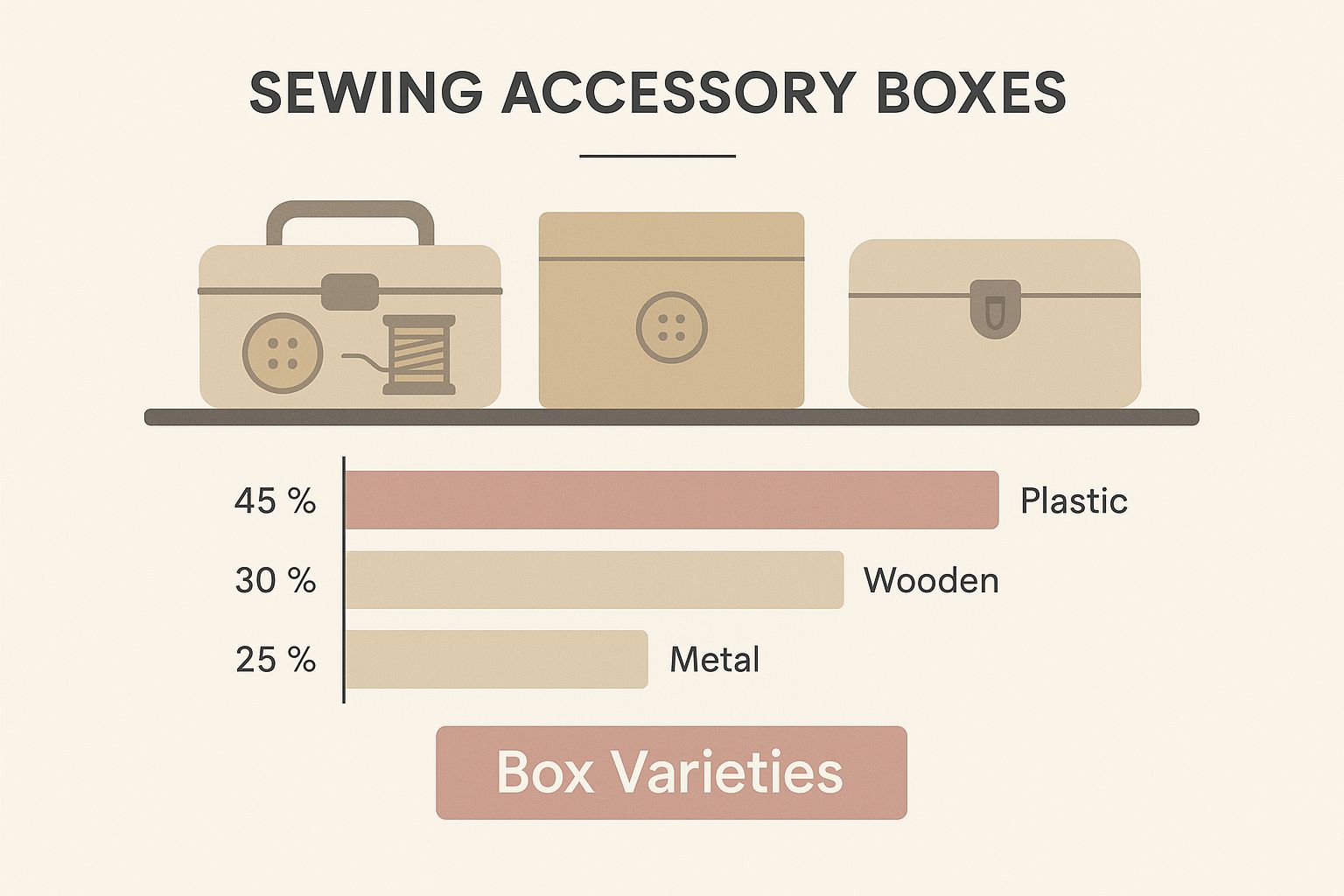
To help you weigh the options, here's a quick comparison of the most common styles you'll find.
Comparing Sewing Box Styles
| Box Style | Best For | Pros | Cons |
|---|---|---|---|
| Cantilever Box | All-purpose crafters | Tiered trays for easy access; often spacious. | Can be bulky and heavy, especially wooden ones. |
| Modular Plastic Case | Quilters & detail work | Customisable compartments; stackable; often clear. | May not fit very large tools like shears easily. |
| Fabric Tote Bag | Sewing on the go | Lightweight; lots of pockets; portable. | Less protection for delicate items; can get cluttered. |
| Simple Lidded Box | Minimalists & beginners | Inexpensive; simple storage for basic supplies. | Lacks internal organisation; items can get jumbled. |
Ultimately, there's no single "best" box—only the one that’s best for you. Finding the right container is a crucial step in setting up a workspace that feels organised and inspiring. For even more ways to create a seamless sewing setup, explore these fantastic top sewing room organisation ideas.
Organising Your Box for an Efficient Workflow
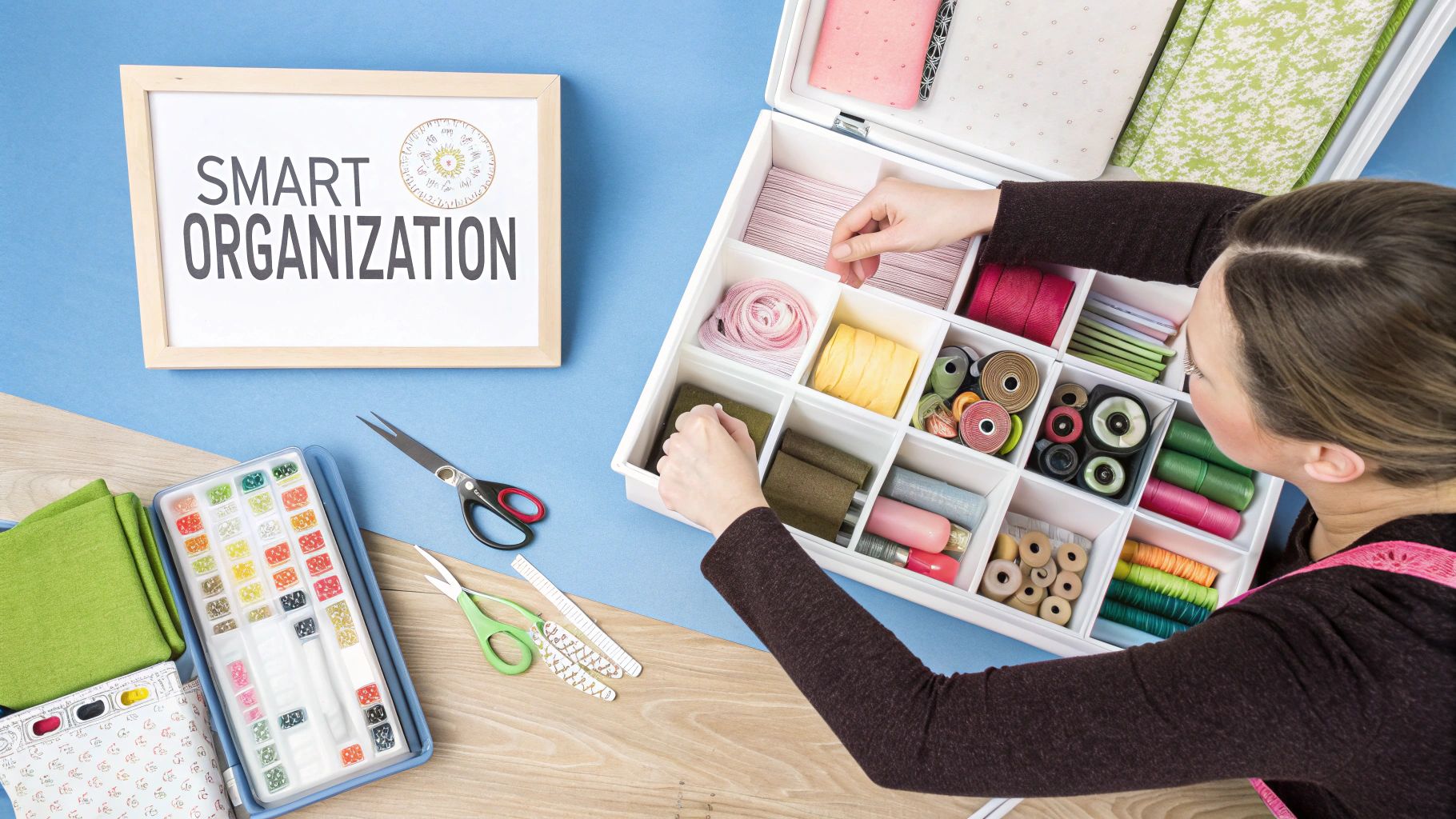
Finding the perfect sewing accessory box is a great start, but the real magic happens when you organise it properly. The aim isn't just to store your tools, but to turn your box into an intuitive extension of your hands—a place where you can find what you need without even looking.
A brilliant way to do this is by ‘zoning’. I find this approach transforms how I work. It’s simple: you create dedicated areas inside your box for tools based on when you use them. For example, all your cutting tools—fabric shears, thread snips, a rotary cutter—live together in one section. Another zone can hold your marking tools, and a third can be for all your stitching essentials like pins and clips.
Smart Organisation Hacks
Sometimes it’s the little things that make the biggest difference. I swear by using small magnetic dishes or even old mint tins inside the larger compartments of my box. They're perfect for corralling loose pins, stray buttons, or spare machine needles, stopping them from vanishing into the depths.
And what about bobbins? We've all been there, untangling a bird's nest of thread. To finally solve the chaos, try using colour-coded bobbin clips or little clear cases. This simple trick lets you instantly match a bobbin to its spool, saving you those frustrating minutes of guesswork.
The ultimate goal is to create a system so intuitive that you never have to break your creative focus. It’s about building muscle memory, where reaching for a seam ripper or a specific presser foot becomes second nature.
This level of organisation is becoming even more crucial as sewing technology moves forward. The global sewing machine market is projected to hit USD 5.53 billion by 2030, partly because of new innovations like AI-guided machines. These advanced models often have their own unique digital parts and specialised tools, making a well-structured sewing box more necessary than ever. It needs to hold both your classic notions and the latest tech.
Arranging for Specific Projects
Your organisation shouldn’t be static. Think about tailoring it to your current project. If you’re about to start a quilt, move your rotary cutter, quilting rulers, and fabric clips into the top, most accessible tray. For a dressmaking project, you’ll want your tailor's chalk, measuring tape, and favourite shears right at your fingertips.
If you’re looking for more ways to get your entire creative space in order, have a look at our guide on sewing room storage ideas. It’s full of inspiration for making your craft room work for you. By taking the time to arrange your supplies thoughtfully, you’ll find your sewing becomes smoother, more enjoyable, and much more productive.
Keeping Your Sewing Box Tidy: Habits for Success
Getting your sewing accessory box perfectly organised is one thing, but keeping it that way? That's the real test. We’ve all been there: you create a beautiful system, and a few projects later, it’s descended back into chaos. The secret isn't a massive, time-consuming clean-up; it's about building small, simple habits that become second nature.
The most powerful habit I've ever adopted is the "end-of-project reset." It's a quick, five-minute ritual that works wonders. When you’ve just put the finishing stitch on a garment, resist the urge to just stash the leftover fabric and walk away. Instead, take those few extra moments to put every last pin, bobbin, and tool back in its proper home. This simple act stops that slow, creeping mess from ever taking hold.
Build Routines That Work for You
Another game-changer is the quick supply check before you start a new project. It takes less than 30 seconds. Just cast your eye over your essentials. Have you got the right thread colour? Are you running low on your go-to universal needles? Spotting these things early saves you that all-too-familiar frustration of having to stop everything mid-seam to hunt for a missing item.
This forward-thinking approach is especially useful as you start collecting more specialised tools. The moment you bring home a new presser foot or a fancy gadget, give it a permanent home in your box. Don't fall into the trap of tossing it in and telling yourself you'll find a spot for it "later."
An organised sewing box isn't just a tidy container; it's an active part of your creative workflow. The aim is to make organisation an effortless part of your sewing rhythm, not another chore to add to your list.
These small, consistent actions are what keep your sewing sessions flowing smoothly and your creative space feeling calm and inspiring. For those who really want to dial in their organisation, a dedicated log can be a brilliant tool. You can find out more about structuring your work with a sewing project planner in our complete guide.
By weaving these simple habits into your routine, you’ll make sure your sewing box remains a hub of efficiency and joy, always ready for your next flash of inspiration.
Let’s be honest, even the most spacious sewing accessory box can only hold so much. If you want to create a truly efficient sewing corner—one that keeps your main workspace clear and your mind focused—you need to think about a complete system where every tool has its place.
Creative Storage Ideas Beyond the Box
A great way to start is by looking up. Going vertical is a classic space-saving trick for a reason. Wall-mounted pegboards are fantastic for hanging scissors, rotary cutters, and rulers. It keeps your most-used tools off your table but still visible and right where you need them.
Don't forget the decorative potential of storage. I love using a collection of clear jars to show off colourful buttons or beautiful ribbons. They become part of the room's decor while staying perfectly organised. And for those delicate paper patterns? Tucking them into binders with plastic sleeves is a simple way to protect them from damage.
The real aim here is to build a whole organisational ecosystem. When you expand your storage strategy beyond a single box, you craft a dedicated sewing space that not only looks wonderful but makes every project flow more smoothly.
This need for smart organisation is growing. With more people embracing sewing as a sustainable hobby, the demand for better storage has never been higher. The UK sewing machine market is actually projected to grow by over USD 20 million between 2023 and 2028, largely driven by activities like upcycling and mending. You can read more about the growth of the UK sewing market and what it means for sewers.
At the end of the day, a tidy setup means less time hunting for a bobbin and more time actually creating. For more specific ideas on containers, take a look at our complete guide to choosing a sewing organiser box that’s just right for you.
Your Sewing Box Questions, Answered
Even with the best intentions, a few nagging questions can pop up when you're trying to get your sewing kit organised. Let's walk through some of the common hurdles I see people face, so you can sort out your supplies with confidence.
What's the best starter box for a complete beginner?
If you're just starting out, my advice is always to go for a medium-sized plastic cantilever box. You know the type – the ones that open up in tiers. They’re fantastic because you can see everything at a glance, they have ready-made compartments for your first bits and bobs, and a sturdy handle makes them easy to tuck away. It gives you just enough structure without feeling like you have to fill a massive space right away.
How do I stop everything from getting tangled?
Ah, the dreaded thread tangle. This is probably the most common frustration I hear about. For your main spools, the best bet is a proper rack or a shallow box with dividers or little dowels to hold them in place. Bobbins are even worse culprits for creating a knotted mess. I’d recommend grabbing some of those little silicone bobbin holders or a small, clear case designed specifically to keep them neat and separate. It's a tiny change that makes a huge difference.
A common misconception is that you need a huge space to be organised. In reality, the most effective storage solutions are the ones that work cleverly within the space you have, no matter how small.
What if I have hardly any space to work with?
If a dedicated sewing room feels like a distant dream, you have to get clever. Think vertically and portably. A rolling craft cart is a brilliant solution because it takes up very little floor space but gives you multiple layers of storage. Another great option is a sturdy fabric sewing tote that you can pack away in a cupboard, paired with a wall-mounted pegboard for the tools you use most. It’s all about finding smart ways to make your limited space work harder for you.
Ready to create a workspace that inspires creativity and efficiency? Find the perfect storage solutions, from tailor's dummies to garment rails, at Display Guru. Explore our collection at https://www.displayguru.co.uk and build the sewing studio of your dreams.
